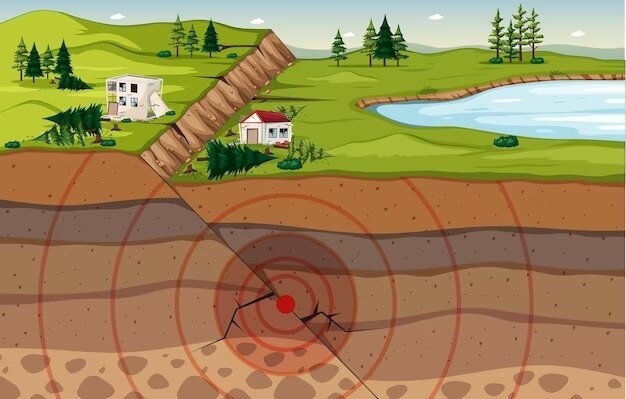Conducting a thorough analysis to identify precursor phenomena for earthquakes

Earthquakes are natural disasters that can have devastating effects on human lives and infrastructure. While short-term prediction of earthquakes is currently not possible, scientists are constantly studying various parameters and phenomena that may serve as precursors to these events. By analyzing seismic and geodetic data, researchers aim to identify patterns and characteristics that could potentially provide valuable information about the occurrence of future earthquakes. In this article, we will explore the latest research on precursor phenomena for earthquakes, focusing on a recent study conducted by seismologists from the GFZ German Research Centre for Geosciences Potsdam, Stanford University, Gebze Technical University, and Kandilli Observatory and Earthquake Research Institute Istanbul.
Understanding the Kahramanmaraş Earthquakes
On February 6th, 2023, a powerful earthquake struck the Kahramanmaraş region in Southeast Türkiye. It was followed by another earthquake, approximately 9 hours later, and about 90 kilometers away from the epicenter of the first one. The combined impact of these earthquakes resulted in almost 60,000 deaths, affected 300,000 buildings, and caused approximately 120 billion USD in financial damage. The first earthquake had a magnitude of MW 7.8 and ruptured multiple fault segments of the 'East Anatolian Fault Zone,' which separates the Anatolian and Arabian tectonic plates. The second earthquake measured MW 7.6.
The Quest for Precursor Phenomena
While short-term earthquake prediction remains elusive, researchers are exploring various measurable parameters and field observations that could potentially serve as precursors to earthquakes. In their study, the team of seismologists led by Dr. Grzegorz Kwiatek, Dr. Patricia Martínez-Garcón, and Dr. Marco Bohnhoff employed seismic catalog and waveform data from regional seismic networks recorded since 2014 to investigate the seismic processes preceding the Kahramanmaraş mainshock.
Spatio-Temporal Analysis of Regional Seismicity
By utilizing the latest statistical and machine learning methods, the researchers conducted a spatiotemporal analysis of regional seismicity. This analysis revealed an intriguing 8-month-long crustal seismicity transient, indicating a preparation process in the region surrounding the earthquake's epicenter. The observed clustering and localization of seismic activity are reminiscent of controlled laboratory rock deformation experiments and have been observed in some large continental earthquakes over the past few decades.
According to Dr. Kwiatek, the lead author of the study, their goal was to identify specific signatures in the seismic catalog and waveform data from the region. By employing statistical and machine-learning-based data processing techniques, they were able to identify distinct characteristics of the seismicity observed within a 50-kilometer radius around the mainshock. Of particular interest were two transient spatio-temporal clusters of seismicity that commenced in June 2022 and were located approximately 20 kilometers from the future earthquake epicenter.
Unveiling the Build-Up of Stress
The occurrence of these two seismicity clusters drew the attention of the researchers, as they represented a clear acceleration of seismic activity in the epicenter region. Furthermore, these clusters exhibited a higher proportion of larger events compared to smaller ones. Dr. Martínez-Garzón, who led the research team, emphasized that these observations suggest a build-up of stress within the future epicenter region in the months leading up to the earthquake. Although other seismicity clusters were observed within the analyzed period as far as 65 kilometers from the epicenter, they did not display equivalent spatio-temporal and statistical properties.
Implications for Intermediate-Term Earthquake Forecasting
Comparing their observations with findings from previous large earthquakes in California, the researchers propose that monitoring seismicity transients may aid in the intermediate-term forecasting of earthquakes. These insights could potentially enhance preparedness and response systems, helping authorities and communities better anticipate and mitigate the impact of future seismic events. However, it is important to note that short-term earthquake prediction remains a long-term goal in seismology and is currently not possible.
While the weeks leading up to the Kahramanmaraş earthquake showed scarce seismic activity in the future mainshock epicentral area, the researchers utilized waveform data and machine learning techniques to detect any short-term acceleration before the mainshock. This method, successfully employed in the analysis of the 1999 MW 7.6 Izmit earthquake in the western portion of the North Anatolian Fault, did not provide evidence of such acceleration in the Kahramanmaraş case.
The Future of Earthquake Monitoring and Warning Systems
Despite the limitations in short-term earthquake prediction, the findings from this study contribute to a deeper understanding of the processes leading to major earthquakes over a span of months. Identifying hotspots for future events several months in advance can provide crucial information to local authorities, enabling them to improve the resilience of population centers located near active faults. This knowledge can be particularly valuable in regions like Istanbul, with its approximately 20 million inhabitants and an overdue large earthquake (M>7).
The refined methods employed in the Kahramanmaraş study will be applied to long-term observations in the Istanbul region. The GFZ Potsdam operates the GONAF observatory, which aims to bridge the gap between controllable laboratory experiments and uncontrollable natural earthquakes. By reducing this observational gap, scientists can gain valuable insights into earthquake dynamics and enhance our ability to monitor and mitigate earthquake risks.
Conclusion
The search for precursor phenomena for earthquakes is an ongoing endeavor in the field of seismology. While short-term earthquake prediction remains elusive, scientists are utilizing advanced techniques and data analysis to identify patterns and characteristics that may serve as indicators of future seismic events. The study conducted by seismologists from the GFZ German Research Centre for Geosciences Potsdam, Stanford University, Gebze Technical University, and Kandilli Observatory and Earthquake Research Institute Istanbul sheds light on the spatio-temporal clustering of seismic activity preceding the devastating Kahramanmaraş earthquakes. This research emphasizes the importance of continued monitoring and analysis of seismic data to enhance our understanding of earthquake dynamics and improve our preparedness for future seismic events.

 How to resolve AdBlock issue?
How to resolve AdBlock issue?